Team Everest Anniversary Post #4: Getting Closer to Base Camp
Gene Rodgers
May 16, 2017
To commemorate the 14th anniversary of CTD's Team Everest '03 Expedition, trekker and long-time CTD member Gene Rodgers shares his memories of the event in a series of guest blog posts. Check in Tuesdays in May for new posts!
Read Post #3: Getting Acclimatized and Acquainted
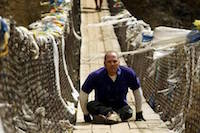 Our progress from Lukla to Phakding along the Dudh Kosi ("Milk River") involved crossing over valleys on suspension bridges. It was exhilarating. Perched high on the Sherpa’s back, I could easily see over the cables that held up the bridge. If the Sherpa slipped and fell sideways, I might’ve fallen over the side into a heap on the rocky terrain below.
Our progress from Lukla to Phakding along the Dudh Kosi ("Milk River") involved crossing over valleys on suspension bridges. It was exhilarating. Perched high on the Sherpa’s back, I could easily see over the cables that held up the bridge. If the Sherpa slipped and fell sideways, I might’ve fallen over the side into a heap on the rocky terrain below.
Mark chose to scoot across bridges on his butt (right).
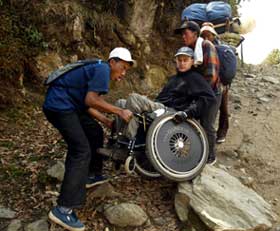 After crossing the bridges, the terrain wasn't very accommodating for those in chairs, either (left: Sherpas assist Riley). Sometimes, we followed obvious trails. Other times, it seemed like we were making our own trail through bushes and over rocks, with very few areas flat enough to roll around. It was also scary being carried on someone’s back, leaning back a little bit in the doko. From our perspective, it looked like the valley was bottomless. Once, Riley’s Sherpa stopped to rest on a stone ledge with his back to the valley. As a result, Riley was suspended over the edge of the trail, far above the valley floor. If the single strap holding the doko on the Sherpa’s head broke, that would’ve be the end of Riley.
After crossing the bridges, the terrain wasn't very accommodating for those in chairs, either (left: Sherpas assist Riley). Sometimes, we followed obvious trails. Other times, it seemed like we were making our own trail through bushes and over rocks, with very few areas flat enough to roll around. It was also scary being carried on someone’s back, leaning back a little bit in the doko. From our perspective, it looked like the valley was bottomless. Once, Riley’s Sherpa stopped to rest on a stone ledge with his back to the valley. As a result, Riley was suspended over the edge of the trail, far above the valley floor. If the single strap holding the doko on the Sherpa’s head broke, that would’ve be the end of Riley.
--
Even though I was acquainted with the other guys in chairs, I never really bonded with them. I expected to develop a kindred relationship with them, but I was different from them since I couldn't wheel myself, even on the smooth floors of lodges. Sometimes I felt like a potted plant; people would just set me somewhere and that’s where I stayed.
Often times, on the trail, I found myself ahead of the pack. That had its perks. At the end of a trek, while some Sherpa set up camp, Tsering would go on a private mission for me–he would bring me noodle dishes that I liked from all the villagers on the trail.
--
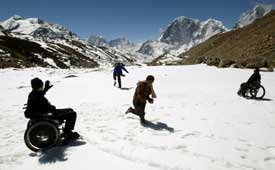 We began the third week by trekking to Dengboche (14,465ft). This village was dwarfed by the surrounding peaks, Lhotse (27,890ft) – the world's 4th highest mountain – and Ama Dablam (22,493ft). Ama Dablam’s ridges look like outstretched arms of a mother protecting her child. We rested and acclimatized in Dengboche, then we climbed to Lobuche (16,170ft).
We began the third week by trekking to Dengboche (14,465ft). This village was dwarfed by the surrounding peaks, Lhotse (27,890ft) – the world's 4th highest mountain – and Ama Dablam (22,493ft). Ama Dablam’s ridges look like outstretched arms of a mother protecting her child. We rested and acclimatized in Dengboche, then we climbed to Lobuche (16,170ft).
Next, we trekked along Khumbu Glacier moraine to Gorak Shep (right), a group of herders' huts. This challenging ascent rewarded us with a 360° panoramic view of Himalayan peaks. We were now at 16,925 ft. elevation, which put us only 3 hours from Everest Base Camp. The air was so thin that physical excursion was becoming minimized.
Tents were comfortable enough, but sometimes we stayed at a lodge. At one lodge, I was lucky to get a shower. It was a cold one, though, as heating fuel, like everything else, was at a premium.
Later, they explained that taking a shower wasn’t a good idea because it’s too burdensome for Sherpa to carry firewood up to the lodge. Being a Sherpa is dangerous because they could be seriously injured or even killed while helping trekkers, leaving no formal financial relief for the family.
--
Nepal offered a plethora of emotion provoking sites. On occasion, we would pass a chorten, a small stone memorial to honor a fallen trekker. Each was no taller than a person. Shapes ranged from piles to artistic towers. They stood against the winds, some more successfully than others. They evoked thoughts of our mortality. Would one of us become a fallen trekker? Would I? Taking stock of my mortality made the air seem fresher, food taste better, and gave mundane tasks a sense of importance.
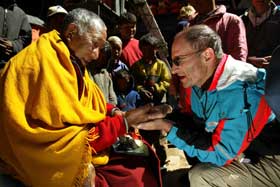
The landscape reminded me of a desert because there was no vegetation. Along the trail, we saw numerous other chortens with prayer flags and/or pictures of fallen climbers on top.
We periodically stopped at Buddhist temples to be blessed by monks. Vince, a Team Everest member and man of the cloth, blessed them in return (left). I loved this interplay because respecting the religion and preferences of every person was the heart of Nepalese culture.
--
Read Post #5: Getting Back Down
Photos by Erich Schlegel, The Dallas Morning News.
About Gene
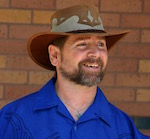 Adventurer, activist, media star, and educator Gene Rodgers earned a bachelors degree in Education, an MBA, and graduate and post-graduate studies in rehabilitation. He has traveled in 44 countries, on six continents, and a number of island nations. He has enjoyed recreational activities and adventure sports including skydiving, sailing, paragliding, scuba diving, and, of course, trekking in the Himalayas. To to share his experiences, Gene created the TV/Web show “The Gene And Dave Show” with Dave Dauber. View the award winning show on Access Austin or TheGeneAndDaveShow.com. Gene is a long-time member of CTD and ADAPT of Texas.
Adventurer, activist, media star, and educator Gene Rodgers earned a bachelors degree in Education, an MBA, and graduate and post-graduate studies in rehabilitation. He has traveled in 44 countries, on six continents, and a number of island nations. He has enjoyed recreational activities and adventure sports including skydiving, sailing, paragliding, scuba diving, and, of course, trekking in the Himalayas. To to share his experiences, Gene created the TV/Web show “The Gene And Dave Show” with Dave Dauber. View the award winning show on Access Austin or TheGeneAndDaveShow.com. Gene is a long-time member of CTD and ADAPT of Texas.


